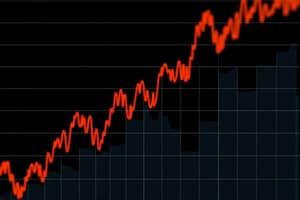Podcast
Questions and Answers
What are the two main types of statistics?
What are the two main types of statistics?
Descriptive Statistics and Inferential Statistics
Define a population in statistics.
Define a population in statistics.
A population is all members of a specified group.
What is a sample?
What is a sample?
A subset of a population.
What type of scale categorizes data but does not rank them?
What type of scale categorizes data but does not rank them?
What methodology is used in econometrics?
What methodology is used in econometrics?
What does the 'Cards' statement allow a user to do in SAS?
What does the 'Cards' statement allow a user to do in SAS?
What can the 'Infile' statement be used for in SAS?
What can the 'Infile' statement be used for in SAS?
What are the two methods mentioned for importing data in SAS where variables do not need to be defined?
What are the two methods mentioned for importing data in SAS where variables do not need to be defined?
The Marginal Propensity to Consume (MPC) for a unit change in income is _____ than zero.
The Marginal Propensity to Consume (MPC) for a unit change in income is _____ than zero.
Flashcards are hidden until you start studying
Study Notes
Econometrics Overview
- Econometrics integrates statistical methods to analyze economic data and draw conclusions.
- Descriptive statistics summarize and visualize data using tables, graphs, and measures.
- Inferential statistics utilize sample data to make predictions or decisions about a larger population, emphasizing the necessity of random sampling.
Populations and Samples
- A population encompasses all members of a defined group, while a sample is a representative subset of that population.
- Sample statistics provide insights into the characteristics of the sample and can be extrapolated to the population.
Measurement Scales
- Nominal scales classify data without implying any order.
- Ordinal scales organize data into categories with a defined rank.
- Ratio scales possess all characteristics of interval scales and include a true zero point.
Methodology of Econometrics
- Steps include:
- Statement of Hypothesis: Example includes stating that the Marginal Propensity to Consume (MPC) from income changes is positive.
- Specification of the Mathematical Model: E.g., Y = β1 + β2X, indicating relationships between variables.
Data Handling in SAS
- Importing raw data to SAS can be done through various methods:
- Cards (Datalines) Statement: Embeds raw data directly in the code with an input statement for variable definition.
- Infile Statement: Extracts data from files located on the hard drive with an input statement for variables.
- Import Wizard: A user-friendly tool for importing data, relying on the file's header for variable names, though less reliable.
- Proc Import: A flexible method allowing for easy data importation without needing predefined variables if headers are present.
Example of Data Input in SAS
- Using the Cards Statement for data input:
- Data is included inline within code, defining variables like Name, Sex, ID, Quiz scores.
- Using the Infile Statement for external file access:
- Specifies a location for the data file while still using the input statement for variable definitions.
Practical Application
- The example data presents a list of students with attributes like name, sex, ID, and quiz scores, showcasing how to structure data in SAS for analysis.
- Commands like Proc Print are used to display the data after input, facilitating data review and examination.
Studying That Suits You
Use AI to generate personalized quizzes and flashcards to suit your learning preferences.




